On the Comparison of Records from Standard and Engineered Fiber Optic Cables at Etna Volcano (Italy)
Abstract
1. Introduction
2. Materials and Setup
3. Methods
3.1. Location of the Channels
3.2. Standard Fiber Stacking
3.3. Standard and Engineered Channel Equivalences
3.4. Signal Saturation Correction
4. Results
4.1. Fiber Signals Relation
4.2. PCA for Signal-Noise Analysis
4.3. Signal Saturation Correction
5. Discussion
5.1. Strain-Rate Difference in Standard and Engineered Fibers
5.2. Standard Multi-Fiber Stack and Improvement
5.3. Saturation
6. Conclusions
Supplementary Materials
Author Contributions
Funding
Institutional Review Board Statement
Informed Consent Statement
Data Availability Statement
Acknowledgments
Conflicts of Interest
Abbreviations
| DDSS | Distributed Dynamic Strain Sensing |
| DAS | Distributed Acoustic Sensing |
| OTDR | Optical Time-Domain Reflectometry |
| SNR | signal-to-noise ratio |
| iDAS | intelligent Distributed Acoustic Sensor |
| CC | Cross-Correlation |
| PCA | Principal Component Analysis |
| CF | Characteristic Function |
Appendix A. Best Stack—Mathematical Demonstration
References
- Fernández-Ruiz, M.R.; Soto, M.A.; Williams, E.F.; Martin-Lopez, S.; Zhan, Z.; Gonzalez-Herraez, M.; Martins, H.F. Distributed acoustic sensing for seismic activity monitoring. APL Photonics 2020, 5, 030901. [Google Scholar] [CrossRef]
- Grattan, K.; Grattan, L.; Meggitt, B. Optical Fiber Sensor Technology: Advanced Applications-Bragg Gratings and Distributed Sensors; Springer Science & Business Media: Berlin/Heidelberg, Germany, 2000; Volume 5. [Google Scholar]
- Shang, Y.; Sun, M.; Wang, C.; Yang, J.; Du, Y.; Yi, J.; Zhao, W.; Wang, Y.; Zhao, Y.; Ni, J. Research progress in distributed acoustic sensing techniques. Sensors 2022, 22, 6060. [Google Scholar] [CrossRef] [PubMed]
- Becker, M.; Coleman, T.; Ciervo, C. Distributed acoustic sensing as a distributed hydraulic sensor in fractured bedrock. Water Resour. Res. 2020, 56, e2020WR028140. [Google Scholar] [CrossRef]
- Miah, K.; Potter, D.K. A review of hybrid fiber-optic distributed simultaneous vibration and temperature sensing technology and its geophysical applications. Sensors 2017, 17, 2511. [Google Scholar] [CrossRef] [PubMed]
- Jousset, P.; Reinsch, T.; Ryberg, T.; Blanck, H.; Clarke, A.; Aghayev, R.; Hersir, G.P.; Henninges, J.; Weber, M.; Krawczyk, C.M. Dynamic strain determination using fibre-optic cables allows imaging of seismological and structural features. Nat. Commun. 2018, 9, 2509. [Google Scholar] [CrossRef]
- Aoyama, K.I.; Nakagawa, K.; Itoh, T. Optical time domain reflectometry in a single-mode fiber. IEEE J. Quantum Electron. 1981, 17, 862–868. [Google Scholar] [CrossRef]
- Failleau, G.; Beaumont, O.; Razouk, R.; Delepine-Lesoille, S.; Landolt, M.; Courthial, B.; Hénault, J.; Martinot, F.; Bertrand, J.; Hay, B. A metrological comparison of Raman-distributed temperature sensors. Measurement 2018, 116, 18–24. [Google Scholar] [CrossRef]
- Horiguchi, T.; Shimizu, K.; Kurashima, T.; Tateda, M.; Koyamada, Y. Development of a distributed sensing technique using Brillouin scattering. J. Light. Technol. 1995, 13, 1296–1302. [Google Scholar] [CrossRef]
- Posey, R., Jr.; Johnson, G.; Vohra, S. Strain sensing based on coherent Rayleigh scattering in an optical fibre. Electron. Lett. 2000, 36, 1. [Google Scholar] [CrossRef]
- Wu, Y.; Richter, P.; Hull, R.; Farhadiroushan, M. Hydraulic frac-hit corridor (FHC) monitoring and analysis with high-resolution distributed acoustic sensing (DAS) and far-field strain (FFS) measurements. First Break 2020, 38, 65–70. [Google Scholar] [CrossRef]
- Hubbard, P.G.; Xu, J.; Zhang, S.; Dejong, M.; Luo, L.; Soga, K.; Papa, C.; Zulberti, C.; Malara, D.; Fugazzotto, F.; et al. Dynamic structural health monitoring of a model wind turbine tower using distributed acoustic sensing (DAS). J. Civ. Struct. Health Monit. 2021, 11, 833–849. [Google Scholar] [CrossRef]
- Lipus, M.P.; Schölderle, F.; Reinsch, T.; Wollin, C.; Krawczyk, C.; Pfrang, D.; Zosseder, K. Dynamic motion monitoring of a 3.6 km long steel rod in a borehole during cold-water injection with distributed fiber-optic sensing. Solid Earth 2022, 13, 161–176. [Google Scholar] [CrossRef]
- Fang, G.; Li, Y.E.; Zhao, Y.; Martin, E.R. Urban near-surface seismic monitoring using distributed acoustic sensing. Geophys. Res. Lett. 2020, 47, e2019GL086115. [Google Scholar] [CrossRef]
- Jousset, P.; Currenti, G.; Schwarz, B.; Chalari, A.; Tilmann, F.; Reinsch, T.; Zuccarello, L.; Privitera, E.; Krawczyk, C.M. Fibre optic distributed acoustic sensing of volcanic events. Nat. Commun. 2022, 13, 1753. [Google Scholar] [CrossRef]
- Krawczyk, C.; Jousset, P.; Currenti, G.; Weber, M.; Napoli, R.; Reinsch, T.; Riccobene, G.; Zuccarello, L.; Chalari, A.; Clarke, A. Monitoring volcanic and seismic activity with multiple fibre-optic Distributed Acoustic Sensing units at Etna volcano. In EGU General Assembly Conference Abstracts, Proceedings of the 22nd EGU General Assembly, Online, 4–8 May 2020; p. 15252. Available online: https://www.egu2020.eu/ (accessed on 22 February 2023).
- Klaasen, S.; Paitz, P.; Lindner, N.; Dettmer, J.; Fichtner, A. Distributed acoustic sensing in volcano-glacial environments—Mount Meager, British Columbia. J. Geophys. Res. Solid Earth 2021, 126, e2021JB022358. [Google Scholar] [CrossRef]
- Shatalin, S.; Parker, T.; Farhadiroushan, M. High definition seismic and microseismic data acquisition using distributed and engineered fiber optic acoustic sensors. In Distributed Acoustic Sensing in Geophysics: Methods and Applications; John Wiley & Sons: Hoboken, NJ, USA, 2021; pp. 1–32. [Google Scholar]
- Alekseev, A.; Gorshkov, B.; Potapov, V.; Taranov, M.; Simikin, D. Random jumps in the phase-OTDR response. Appl. Opt. 2022, 61, 231–240. [Google Scholar] [CrossRef]
- Richter, P.; Parker, T.; Woerpel, C.; Wu, W.; Rufino, R.; Farhadiroushan, M. High-resolution distributed acoustic sensor using engineered fiber for hydraulic fracture monitoring and optimization in unconventional completions. In SEG Technical Program Expanded Abstracts 2019; Society of Exploration Geophysicists: Houston, TX, USA, 2019; pp. 4874–4878. [Google Scholar]
- Li, Y.; Karrenbach, M.; Ajo-Franklin, J. Distributed Acoustic Sensing in Geophysics: Methods and Applications; John Wiley & Sons: Hoboken, NJ, USA, 2022; Volume 268. [Google Scholar]
- Masoudi, A.; Belal, M.; Newson, T. A distributed optical fibre dynamic strain sensor based on phase-OTDR. Meas. Sci. Technol. 2013, 24, 085204. [Google Scholar] [CrossRef]
- Becker, M.W.; Coleman, T.I. Distributed acoustic sensing of strain at earth tide frequencies. Sensors 2019, 19, 1975. [Google Scholar] [CrossRef]
- Obermann, A.; Sánchez-Pastor, P.; Wu, S.M.; Wollin, C.; Baird, A.F.; Isken, M.P.; Clinton, J.; Goertz-Allmann, B.P.; Dahm, T.; Wuestefeld, A.; et al. Combined Large-N Seismic Arrays and DAS Fiber Optic Cables across the Hengill Geothermal Field, Iceland. Seismol. Soc. Am. 2022, 93, 2498–2514. [Google Scholar]
- Lindsey, N.J.; Dawe, T.C.; Ajo-Franklin, J.B. Illuminating seafloor faults and ocean dynamics with dark fiber distributed acoustic sensing. Science 2019, 366, 1103–1107. [Google Scholar] [CrossRef]
- Flóvenz, Ó.G.; Wang, R.; Hersir, G.P.; Dahm, T.; Hainzl, S.; Vassileva, M.; Drouin, V.; Heimann, S.; Isken, M.P.; Gudnason, E.Á.; et al. Cyclical geothermal unrest as a precursor to Iceland’s 2021 Fagradalsfjall eruption. Nat. Geosci. 2022, 15, 397–404. [Google Scholar] [CrossRef]
- Lindsey, N.J.; Rademacher, H.; Ajo-Franklin, J.B. On the broadband instrument response of fiber-optic DAS arrays. J. Geophys. Res. Solid Earth 2020, 125, e2019JB018145. [Google Scholar] [CrossRef]
- Currenti, G.; Jousset, P.; Napoli, R.; Krawczyk, C.; Weber, M. On the comparison of strain measurements from fibre optics with a dense seismometer array at Etna volcano (Italy). Solid Earth 2021, 12, 993–1003. [Google Scholar] [CrossRef]
- Farhadiroushan, M.; Parker, T.; Shatalin, S. Method and Apparatus for Optical Sensing. European Patent No. EP 3 265 757 B1, 8 August 2020. [Google Scholar]
- Farhadiroushan, M.; Parker, T.; Shatalin, S. Method and Apparatus for Optical Sensing. US Patent No. US 10,883,861 B2, 5 January 2021. [Google Scholar]
- Parker, T.; Shatalin, S.; Farhadiroushan, M. Distributed Acoustic Sensing—A new tool for seismic applications. First Break 2014, 32, 61–69. [Google Scholar] [CrossRef]
- Conway, C.; Mondanos, M. An introduction to fibre optic Intelligent Distributed Acoustic Sensing (iDAS) technology for power industry applications. In Proceedings of the 9th International Conference on Insulated Power Cables, Jicable15, Versailles, France, 23–27 June 2015; pp. 21–25. [Google Scholar]
- Abdi, H.; Williams, L.J. Principal component analysis. Wiley Interdiscip. Rev. Comput. Stat. 2010, 2, 433–459. [Google Scholar] [CrossRef]
- Pyatykh, S.; Hesser, J.; Zheng, L. Image noise level estimation by principal component analysis. IEEE Trans. Image Process. 2012, 22, 687–699. [Google Scholar] [CrossRef]
- Aki, K.; Richards, P.G. Quantitative Seismology; University Science Books: Melville, NY, USA, 2002. [Google Scholar]
- Reinsch, T.; Thurley, T.; Jousset, P. On the mechanical coupling of a fiber optic cable used for distributed acoustic/vibration sensing applications—A theoretical consideration. Meas. Sci. Technol. 2017, 28, 127003. [Google Scholar] [CrossRef]
- Han, B.; Guan, H.; Yao, J.; Rao, Y.J.; Ran, Z.; Gong, Y.; Li, Q.; Li, M.; Zhang, R.; An, S.; et al. Distributed acoustic sensing with sensitivity-enhanced optical cable. IEEE Sens. J. 2020, 21, 4644–4651. [Google Scholar] [CrossRef]
- Her, S.C.; Huang, C.Y. Effect of coating on the strain transfer of optical fiber sensors. Sensors 2011, 11, 6926–6941. [Google Scholar] [CrossRef]
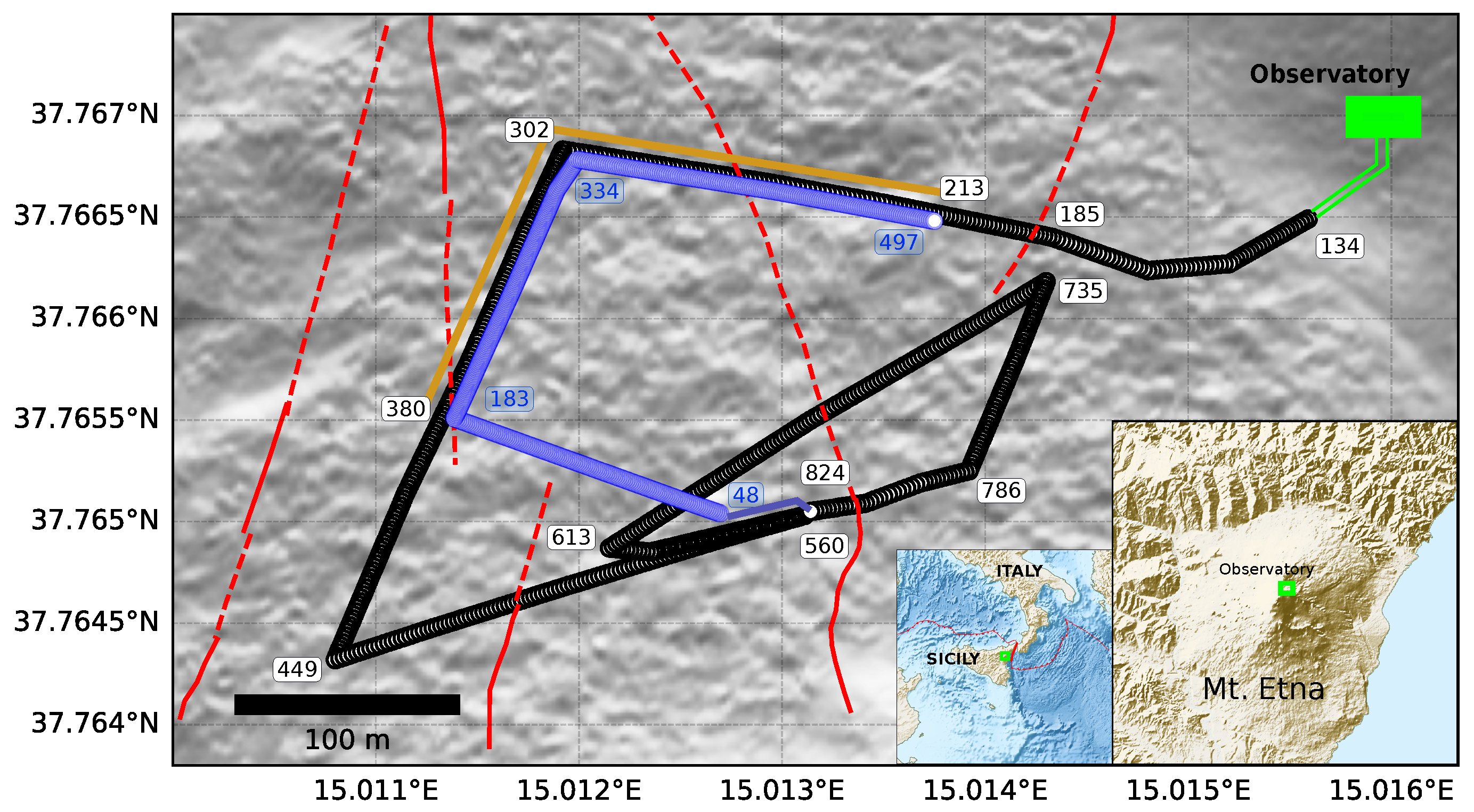

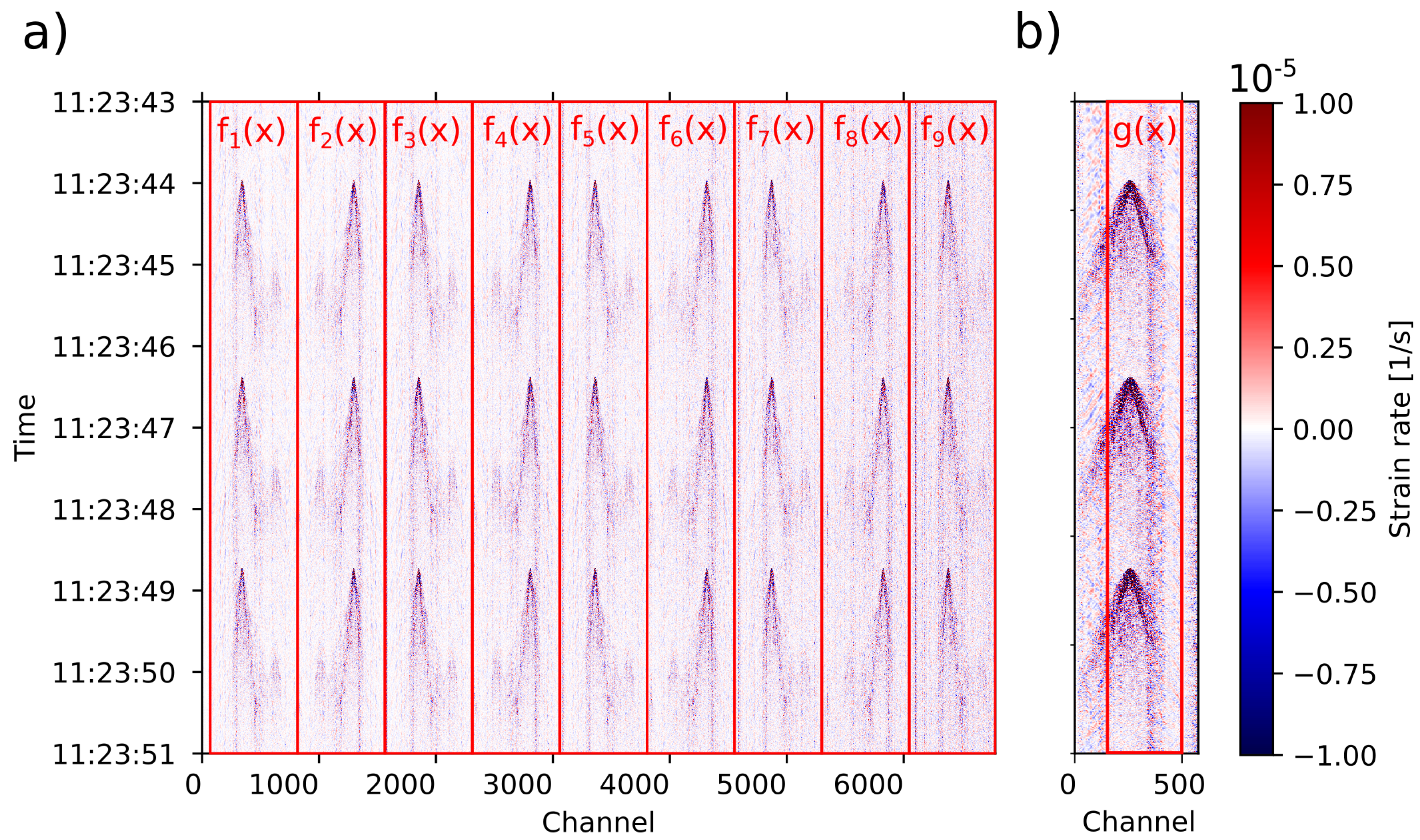


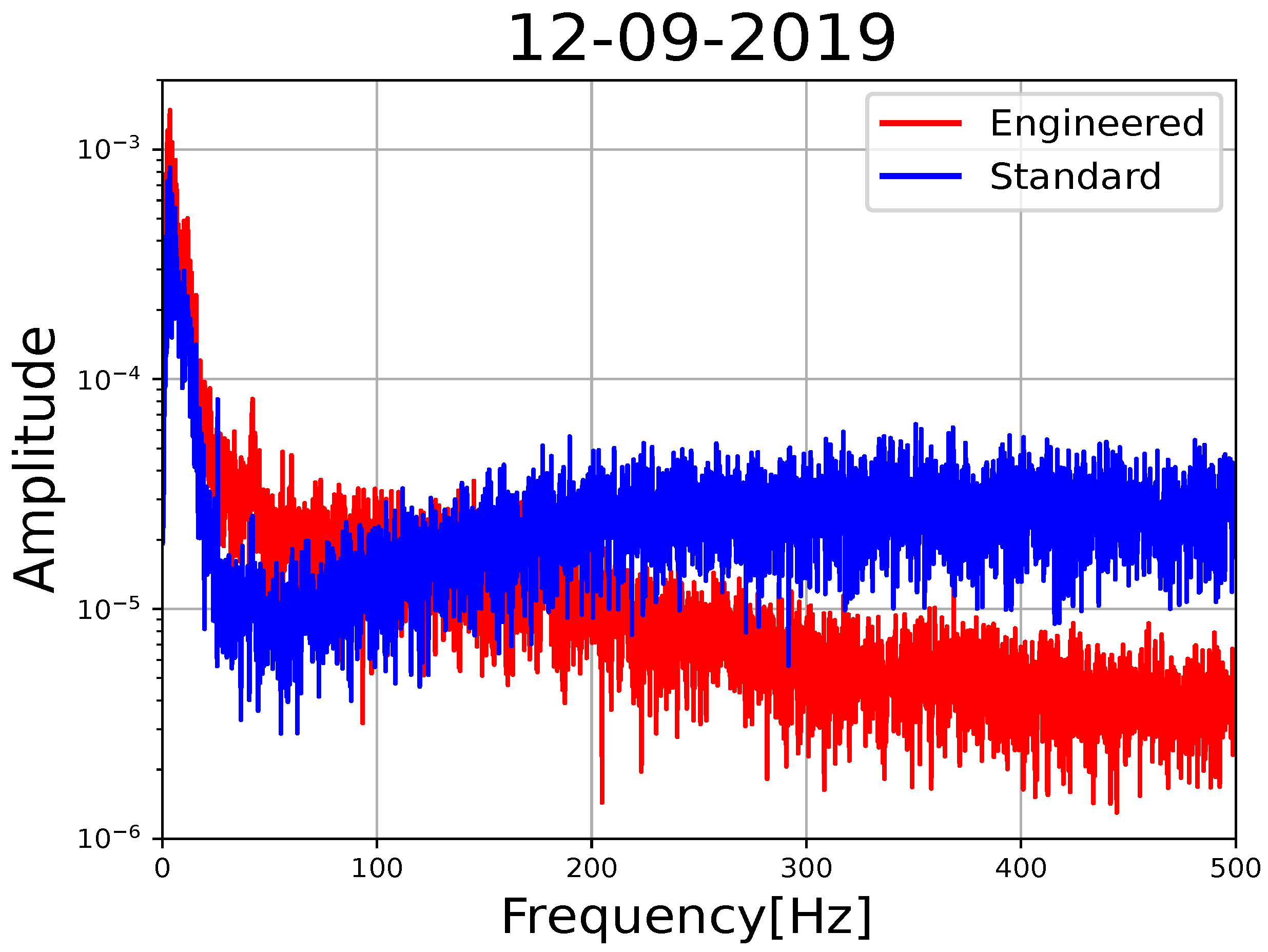
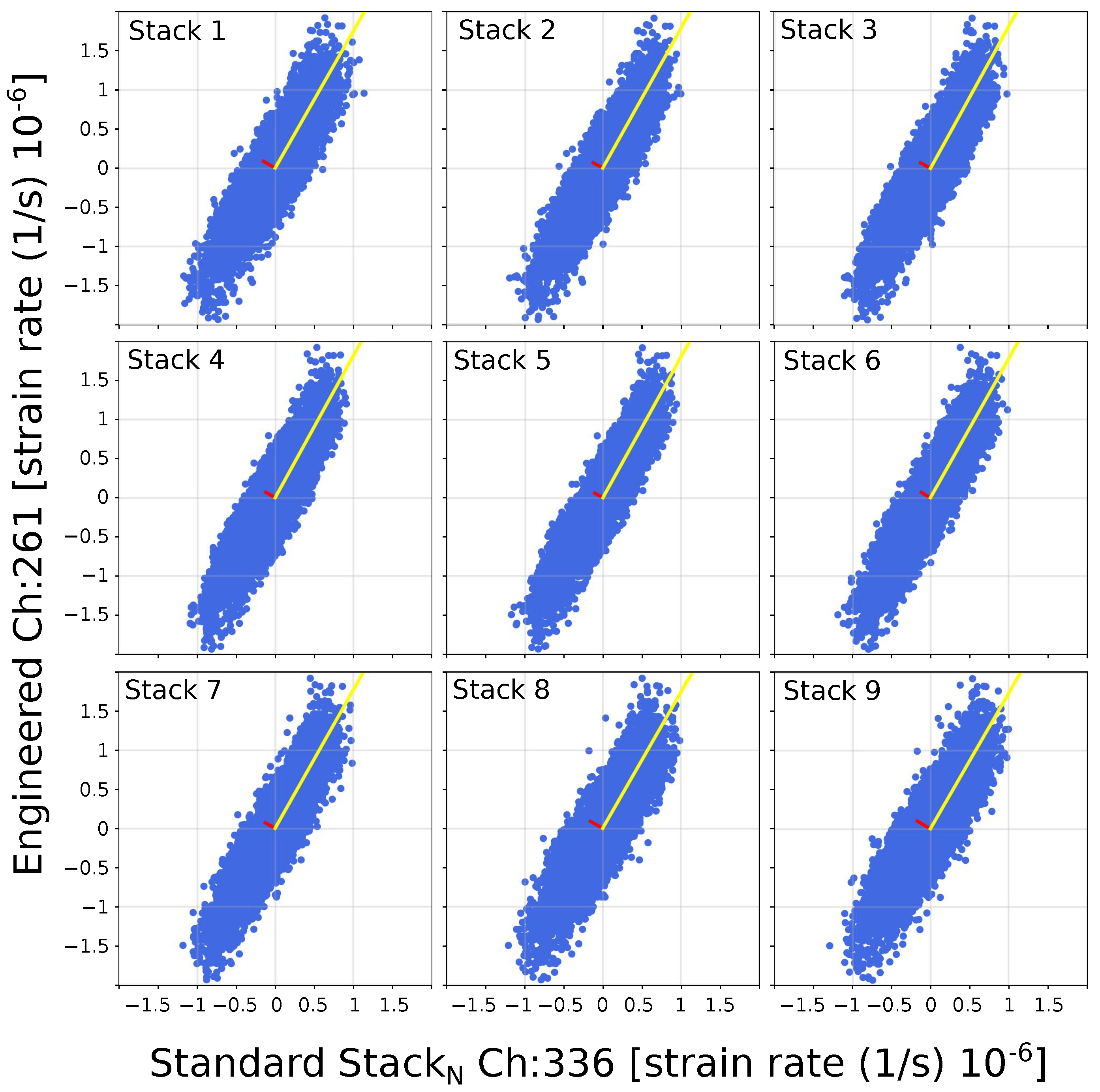
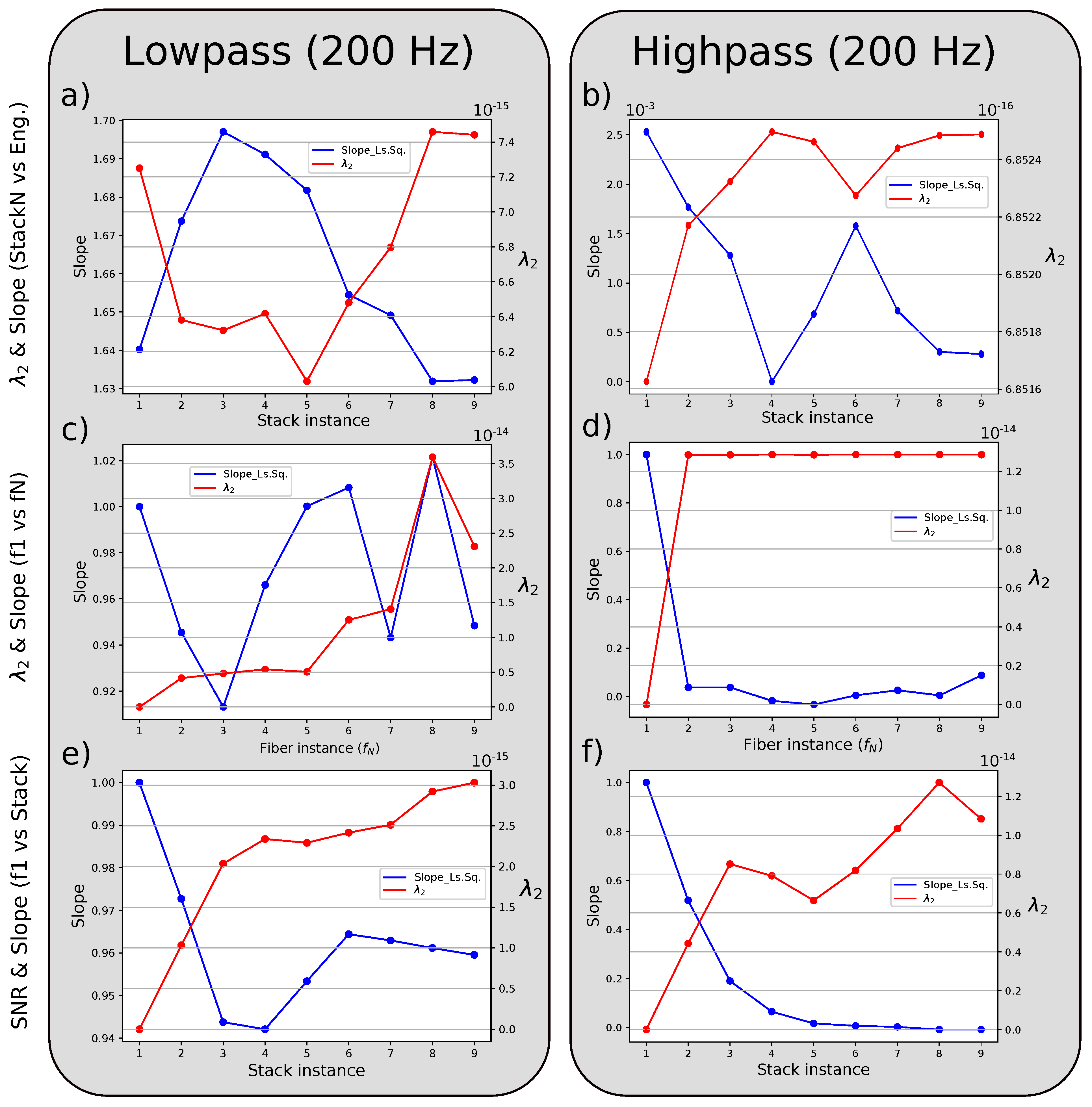
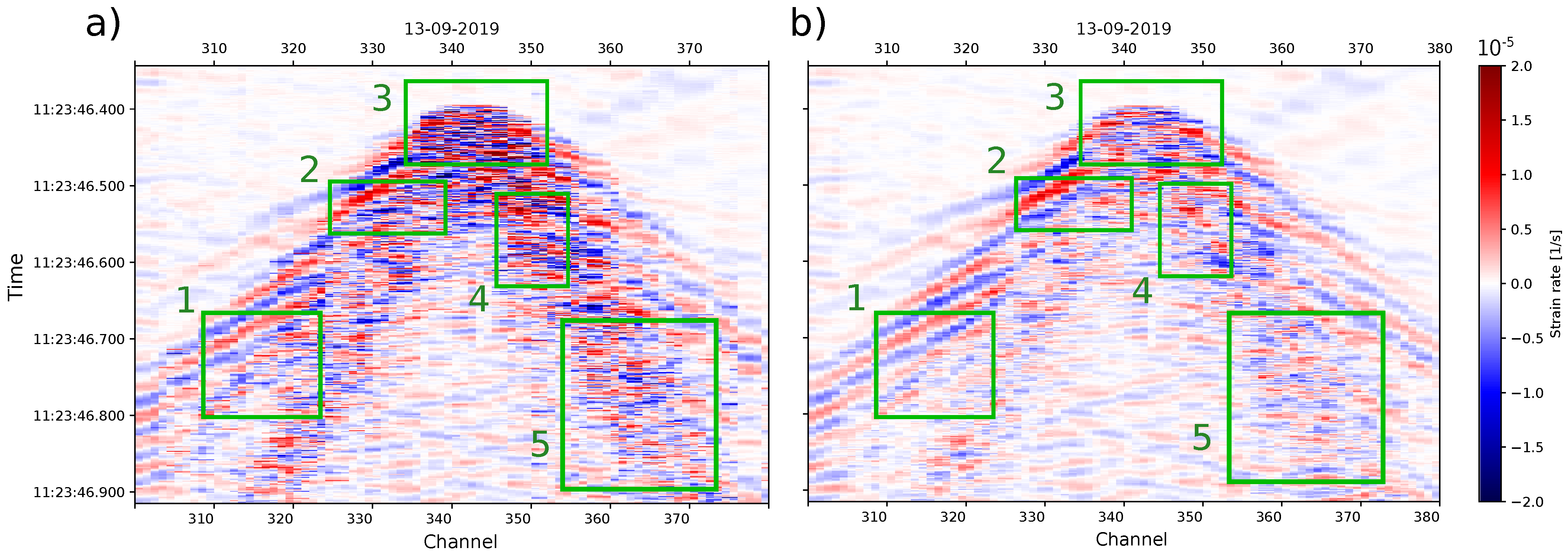
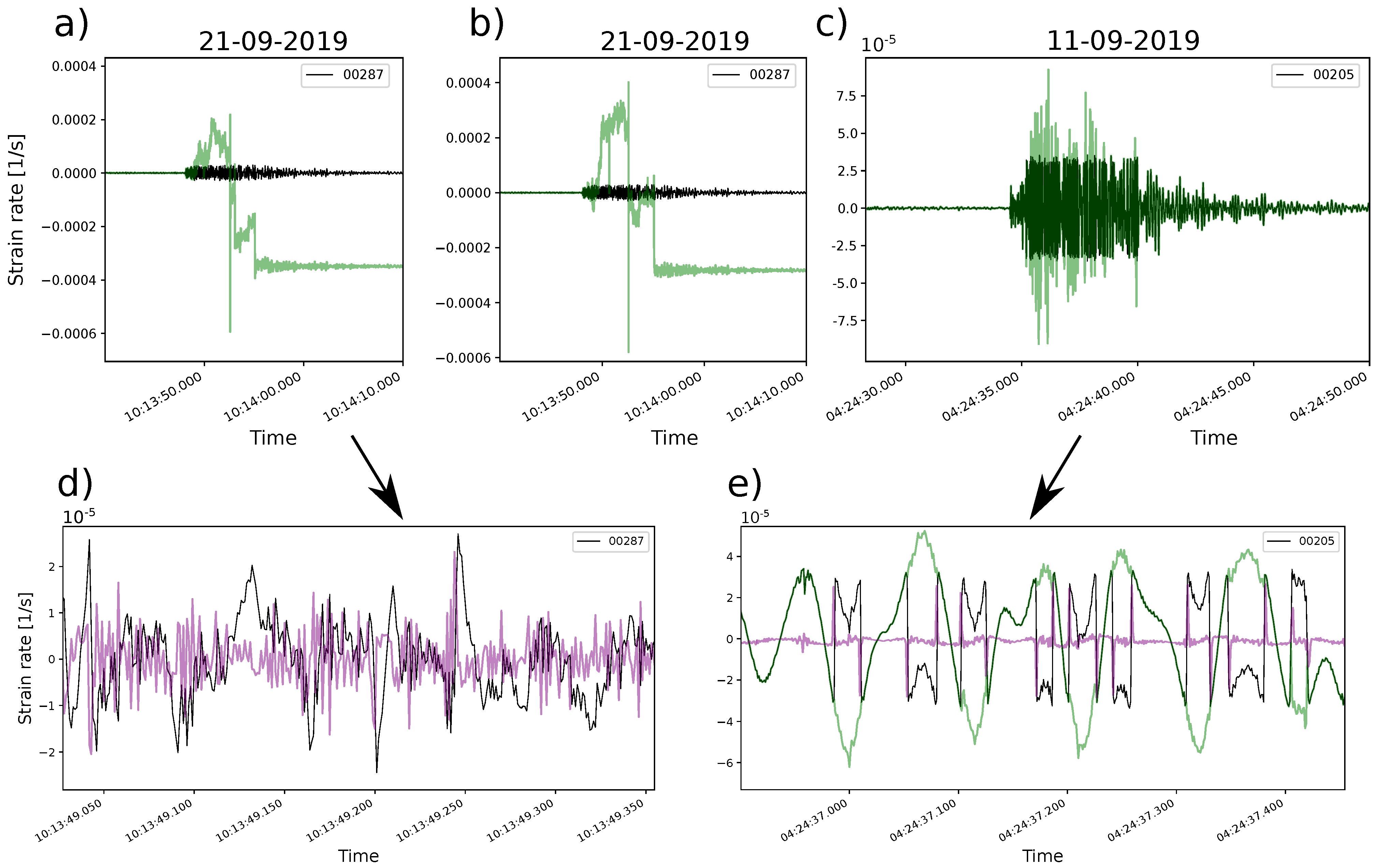
Disclaimer/Publisher’s Note: The statements, opinions and data contained in all publications are solely those of the individual author(s) and contributor(s) and not of MDPI and/or the editor(s). MDPI and/or the editor(s) disclaim responsibility for any injury to people or property resulting from any ideas, methods, instructions or products referred to in the content. |
© 2023 by the authors. Licensee MDPI, Basel, Switzerland. This article is an open access article distributed under the terms and conditions of the Creative Commons Attribution (CC BY) license (https://creativecommons.org/licenses/by/4.0/).
Share and Cite
Diaz-Meza, S.; Jousset, P.; Currenti, G.; Wollin, C.; Krawczyk, C.; Clarke, A.; Chalari, A. On the Comparison of Records from Standard and Engineered Fiber Optic Cables at Etna Volcano (Italy). Sensors 2023, 23, 3735. https://doi.org/10.3390/s23073735
Diaz-Meza S, Jousset P, Currenti G, Wollin C, Krawczyk C, Clarke A, Chalari A. On the Comparison of Records from Standard and Engineered Fiber Optic Cables at Etna Volcano (Italy). Sensors. 2023; 23(7):3735. https://doi.org/10.3390/s23073735
Chicago/Turabian StyleDiaz-Meza, Sergio, Philippe Jousset, Gilda Currenti, Christopher Wollin, Charlotte Krawczyk, Andy Clarke, and Athena Chalari. 2023. "On the Comparison of Records from Standard and Engineered Fiber Optic Cables at Etna Volcano (Italy)" Sensors 23, no. 7: 3735. https://doi.org/10.3390/s23073735
APA StyleDiaz-Meza, S., Jousset, P., Currenti, G., Wollin, C., Krawczyk, C., Clarke, A., & Chalari, A. (2023). On the Comparison of Records from Standard and Engineered Fiber Optic Cables at Etna Volcano (Italy). Sensors, 23(7), 3735. https://doi.org/10.3390/s23073735





